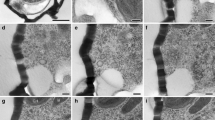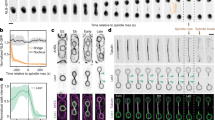Summary
Mitosis and cytokinesis in the pennateDiatoma is described. Prior to division, a doubled “Persistent Polar Complex” (PPC), the focus of numerous cytoplasmic microtubules, migrates from near the nucleus to one side of the cell near the girdle bands, followed by the nucleus. The central dense core of the doubled PPC breaks down as a central spindle grows between the two PPCs, which now each become characteristically associated with a small vacuole and other features of unknown significance. The tubules of the central spindle terminate in a layer, the “Spindle Insertion” (SI), close to the PPCs; other, “polar” tubules radiate from each SI, mostly toward the nucleus, which becomes increasingly deformed by them until the nuclear envelope is ruptured. The elongating spindle enters one side of the nucleus laterally; as shown previously, the central spindle consists of two interdigitated half spindles, but the polar tubules which diverge laterally from the SI, by metaphase form a complex, cone-shaped array emanating from each pole. Some polar tubules penetrate the chromatin and may represent true kinetochore tubules; others, which persist conspicuously throughout mitosis, extend tangentially past the chromatin, out into the cytoplasm, intersecting with those from the other pole. The core structure of the PPCs alters from being plate-shaped at prophase, to being rod-like by metaphase. The chromosomes form a donut-shaped mass of chromatin penetrated by the central spindle throughout meta-and anaphase. Chromosomal separation is accomplished in two stages: the chromatin splits and moves up to the SI, and then the central spindle elongates, concurrent with its overlap region decreasing markedly in extent. Thus, this latter part of anaphase movement could be generated by microtubule sliding past microtubule. Then each PPC distinctly separates from its SI, and moves away from the daughter nucleus during cytokinesis; it again becomes the focus of numerous tubules and often ends up in one corner of the daughter cell. Meanwhile, the central spindle and the SIs, now surmounted by the reforming telophase nuclei, slowly disintegrate during cleavage.
Cytokinesis proceeds in two stages. The cleavage furrow is very broad around the cell periphery; this broadened profile is maintained thereafter, and may later serve to mould the edge of the newly secreted valve. From the broad furrow grows a much narrower cleavage furrow, whose ingrowing edge is lined with dense (contractile -?) filaments; some larger cell organelles are drawn in to line the surface of this furrow. Secretion of the new valve is briefly described.
Similar content being viewed by others
References
Bouck, G. B., andD. L. Brown, 1973: Microtubule biogenesis and cell shape inOchromonas. I. The distribution of cytoplasmic and mitotic microtubules. J. Cell Biol.56, 340–359.
Byers, B., andD. H. Abramson, 1968: Cytokinesis in HeLa: Post-telophase delay and microtubule-associated motility. Protoplasma66, 413–435.
Coombs, J., J. A. Lauritis, W. M. Darley, andB. E. Volcani, 1968: Studies on the biochemistry and fine structure of silicia shell formation in diatomas. V. Effects of colchicine on wall formation inNavicula pelliculosa (Breb.) Hilse. Z. Pflanzenphysiol.59, 124–152.
Crawford, R. M., 1973: The protoplasmic ultrastructure of the vegetative cell ofMelosira varians C. A. Agardh. J. Phycol.9, 50–61.
Dawson, P. A., 1973: Observations on the structure of some forms ofGomphonema parvulum Kütz. III. Frustule formation. J. Phycol.9, 353–365.
Drum, R. W., andH. S. Pankratz, 1963: Fine structure of a diatom centrosome. Science142, 61–62.
Geitler, L., 1971: Über Differenzierung der Kettenkolonien vonDiatoma elongatum undvulgare. Österr. bot. Z.119, 404–409.
Inoue, S., andH. Sato, 1967: Cell motility by labile association of molecules. J. gen. Physiol.50, 259–292.
Kubai, D. F., andH. Ris, 1969: Division in the dinoflagellateGyrodinium cohnii (Schiller). A new type of nuclear reproduction. J. Cell Biol.40, 508–528.
Lauterborn, R., 1896: Untersuchungen über Bau, Kernteilung und Bewegung der Diatomeen. Leipzig: W. Engelmann.
Lerbs, V., andCh. Thielke, 1969: Die Entstehung der Spindel während der Meiose vonCoprinus radiatus. Arch. Mikrobiol.68, 95–98.
Manton, I., K., Kowallik, andH. A. vonStosch, 1969 a: Observations on the fine structure and development of the spindle at mitosis and meiosis in a marine centric diatom (Lithodesmium undulatum). I. Preliminary survey of mitosis in spermatogonia. J. Microscopy89, 295–302.
— — —, 1969 b: Observations on the fine structure and development of the spindle at mitosis and meiosis in a marine centric diatom (Lithodesmium undulatum). II. The early meiotic stages in male gametogenesis. J. Cell Sci.5, 271–298.
— — —, 1970 a: Observations on the fine structure and development of the spindle at mitosis and meiosis in a marine centric diatom (Lithodesmium undulatum). III. The later stages of meiosis I in male gametogenesis. J. Cell Sci.6, 131–157.
— — —, 1970 b: Observations on the fine structure and development of the spindle at mitosis and meiosis in a marine centric diatom (Lithodesmium undulatum). IV. The second meiotic division and conclusion. J. Cell Sci.7, 407–443.
Marchant, H. J., andJ. D. Pickett-Heaps, 1970: Ultrastructure and differentiation ofHydrodictyon reticulum. I. Mitosis in the coenobium. Aust. J. biol. Sci.23, 1173–1186.
McCully, E. K., andC. F. Robinow, 1972 a: Mitosis in heterobasidiomycetous yeasts. I.Leucosporidium scotii (Candida scotii). J. Cell Sci.10, 857–881.
— —, 1972 b: Mitosis in heterobasidiomycetous yeasts. II.Rhodosporidium sp. (Rhodotorula glutinis) andAessospron salmonicolor (Sporobolomyces salmonicolor). J. Cell Sci.11, 1–31.
McIntosh, J. R., P. K. Hepler, andD. G. van Wie, 1969: Model for mitosis. Nature224, 659–663.
—, andS. C. Landis, 1971: The distribution of spindle microtubules during mitosis in cultured human cells. J. Cell Biol.49, 468–497.
Nicklas, R. B., 1971: “Mitosis”. In: Advances in Cell Biology (D. M. Prescott, L. Goldstein, andE. McConkey, eds.), pp. 225–297. New York: Appleton-Century-Crofts.
O'Brien, T. P., 1972: The cytology of cell wall formation in some eukaryotic cells. Bot. Rev.38, 87–118.
Paweletz, N., 1967: Zur Funktion des „Fleming-Körpus“ für die Teilung tierischer Zellen. Naturwissenschaften54, 533–535.
—, 1974: Elektronenmikroskopische Untersuchungen an frühen Stadien der Mitose bei HeLaZellen. Cytobiologie9, 368–390.
Pickett-Heaps, J. D., 1969: The evolution of the mitotic apparatus: An attempt at comparative ultrastructural cytology in dividing plant cells. Cytobios1, 257–280.
Pickett-Heaps, J. D., 1970: Some ultrastructural features ofVolvox, with particular reference to the phenomenon of inversion. Planta90, 174–190.
—, 1971: The autonomy of the centriole: fact or fallacy? Cytobios3, 205–214.
—, 1974 a: The evolution of mitosis and the eucaryotic condition. Bio Systems6, 37–48.
—, 1974 b: Scanning electron microscopy of some cultured desmids. Trans. am. microscop. Soc.93, 1–23.
Ris, H., andD. F. Kubai, 1974: An unusual mitotic mechanism in the parasitic protozoanSyndinium sp. J. Cell Biol.60, 702–720.
Ross, R., andP. A. Sims, 1972: The fine structure of the frustule in centric diatoms: a suggested terminology. Brit. Phycol. J.7, 139–163.
Round, F. E., 1971: Observations on girdle bands during cell division in: the diatomStephanodiscus. Brit. Phycol. J.6, 135–143.
Schroeder, T. E., 1970: The contractile ring. I. Fine structure of dividing mammalian (HeLa) cells and the effects of cytochalasin B. Z. Zellforsch.109, 431–449.
Slankis, T., andS. P. Gibbs, 1972: The fine structure of mitosis and cell division in the Chrysophycean algaOchromonas danica. J. Phycol.8, 243–256.
Spurr, A. R., 1969: A low viscosity epoxy embedding medium for electron microscopy. J. Ultrastruct. Res.26, 31–43.
Stoermer, E. F., H. S. Pankratz, andC. C. Bowen, 1965: Fine structure of the diatomAmphipleura pellucida. II. Cytoplasmic fine structure and frustule formation. Amer. J. Bot.52, 1067–1078.
Tippit, D. H., K. L.McDonald, and J. D.Pickett-Heaps, 1975: Cell division in the centric diatomMelosira. Cytobiologie. In press.
Weisenberg, R. C., 1972: Microtubule formationin vitro in solutions containing low calcium concentrations. Science177, 1104–1105.
Author information
Authors and Affiliations
Rights and permissions
About this article
Cite this article
Pickett-Heaps, J.D., McDonald, K.L. & Tippit, D.H. Cell division in the pennate diatomDiatoma vulgare . Protoplasma 86, 205–242 (1975). https://doi.org/10.1007/BF01275633
Received:
Revised:
Issue Date:
DOI: https://doi.org/10.1007/BF01275633




